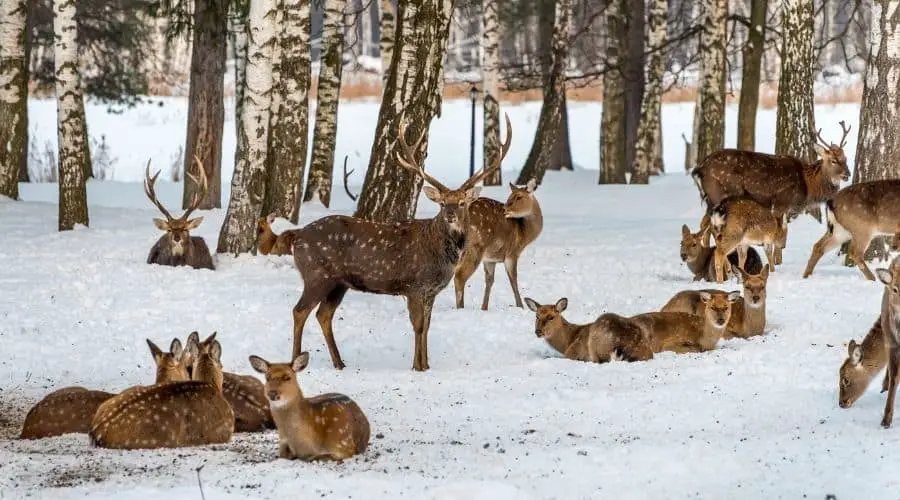Deer prefer to come back to the same sleeping spot over and over. They are creatures of habit, and the dominant males may become so attached to their favorite ‘bed’ that they kick other deer out so they can have ‘their’ spot. Where do deer go to sleep in the winter?
Deer sleep under the shelter of trees in the winter, especially coniferous trees like pine, cedar, fir, spruce and hemlock trees that maintain their leaves year-round. These trees have wide trunks and low boughs that cut down on the cold wind and provide protection. Deer do not hibernate, so they have well-adapted winter coats to keep them warm while they sleep in the winter temperatures.
Table of Contents
5 Places Deer Sleep In The Winter
1 – Under The Trees/In The Forest
Deer typically sleep in stands of coniferous trees known as deer yards during the winter. They also do this in warmer months, but for different reasons.
Other animals, such as rabbits, have also been known to shelter under trees when caught out in the cold. The branches full of leaves can help keep water or snow off the deer, so it doesn’t permeate their fur and freeze.
Wide trunks and low boughs also cut down any winds. By reducing the air movement, it helps prevent the deer from getting even colder.
Fortunately, deer add hardier, more calorie-dense foods like nuts, berries, and mushrooms to their cold season diet. The richer food helps them put on weight, and the resulting layer of fat protects them against some of the cold.
According to Reconnect With Nature, “When the weather is particularly harsh, deer act just like we do: They hunker down, sometimes staying in place for days. But unlike us, deer don’t have a steady supply of food while hunkered down, so they instead rely on their fat stores to help them survive.”
2 – South Facing Slopes
Some deer prefer to sleep in the open, where they can readily smell predators coming and take full advantage of any sunlight.
There are forty-three species of deer, and many of these live in North America. As a result, what works for one species or group may not be effective for another.
For example, elk and reindeer in Alaska have very different sleeping habits from mule deer found in the Arizona desert.
According to Ranch And Farm Properties, “A southwest-facing slope provides two key elements a buck will look for in a bedding area: headwind and sunshine. This allows them to smell danger long before they see it and seek out a little warmth in the colder months.”
Mule deer, which prefer open countryside over the denser forests frequented by their white-tailed cousins, often choose this sleeping option.
3 – In The Sun
Deer are nocturnal, so they sleep in the day. Even when there’s a thick blanket of snow on the ground, sunshine helps warm you up.
Since deer sleep around twelve hours a day in the hot seasons and even more when it’s cold, they can use all the sunlight to help keep their bodies warm.
For deer who live in a region where snow is rare, then they naturally stay warmer. However, snow reflects a lot of sunlight and will still help warm the deer during the day.
At night the deer are more active. By moving around and foraging for food, they stay warm when temperatures are coldest.
Plus, being nocturnal gives them an advantage over hunters and predators who are more likely to be up in the daytime and safe at home or in a den at night.
There are some predators in winter, but in general, it’s a safer time for the deer to be out. Bears are hibernating, and other large carnivores are likely to stay inside where it is warmer if they aren’t too hungry.
Combined with their less active winter lifestyle, which slows their metabolism, it’s an excellent sleep strategy for freezing temperatures.
4 – In Cattails
Cattails tend to grow thickly, and they get very tall. Deer who live in prairie areas can use that to their advantage.
As the seasons change and the cattail stalks die, they will slump over naturally. There aren’t many things that eat the dry stalks so that the cattails can provide a lot of cover.
Deer will find sloughs of cattails where the bunched-up plants form a naturally sheltered area. Like sleeping in a forest full of coniferous trees, these plants are large enough and dense enough to block the wind and cut down some precipitation.
Deer who sleep in cattails or other similar dead-plant structures are at least partly protected from the weather.
They can hunker down and live off their fat reserves for a while if it’s snowy or raining and emerge to forage when necessary.
5 – Under A Ridge
Probably one of the last choices for a deer sleep spot is under a ridge. Any overhead protection is better than none if the weather gets bad enough.
However, a ridge is neither as open and easy to spot predators nor as sheltered as a thickly forested area where deer can hide.
An overhang is more likely to be a temporary or last-ditch type option for most deer species.
Any place with adequate cover, protection from the elements, and sufficient quantities of food can be an excellent spot to rest for the night.
Most deer stay within roughly a square mile for most of their lives, but some migrate, and they all move around to eat and stay safe.
Helpful Tips To Know Where Deer Sleep In The Winter
All deer rest more in the winter. By eating high-calorie foods and growing a winter coat, most deer can easily survive harsh winters. It’s incredibly rare for a deer to freeze, though technically possible.
Here are more helpful tips to know about where deer sleep in winter.
- It is hard to tell what an animal is thinking, but there’s evidence that deer dream while they sleep. Trail cameras have caught deer asleep, but with their eyes moving in the well-recognized REM or Random Eye Movements that indicate the brain is active in its unconscious state.
- A deer’s winter coat consists of longer guard hairs and a much denser undercoat than they sport in summer.
- Deer tuck their heads into their back legs when it’s cold. Meanwhile, when it is warmer outside, they may rest their chin on the ground in front of them, or turn and rest with their head on their back and shoulder. By doing this the deer can either warm their nose or use those big ears to catch a breeze and cool off.
- Most deer have very short sleep cycles. They only wholly fall asleep for around thirty minutes at a time.
Final Thoughts
Humans can light a fire, go indoors, or make a thick blanket to stay warm while we sleep in the winter, but deer have adapted in other ways.
Growing a thicker coat, putting on fat, and slowing their metabolism all help these beautiful creatures live through the cold months.
Plus, sleeping in the day when it’s warmer is an intelligent move for winter survival. However, deer have learned to sleep under coniferous trees and other natural shelters to help avoid the worst of the chill and precipitation.

